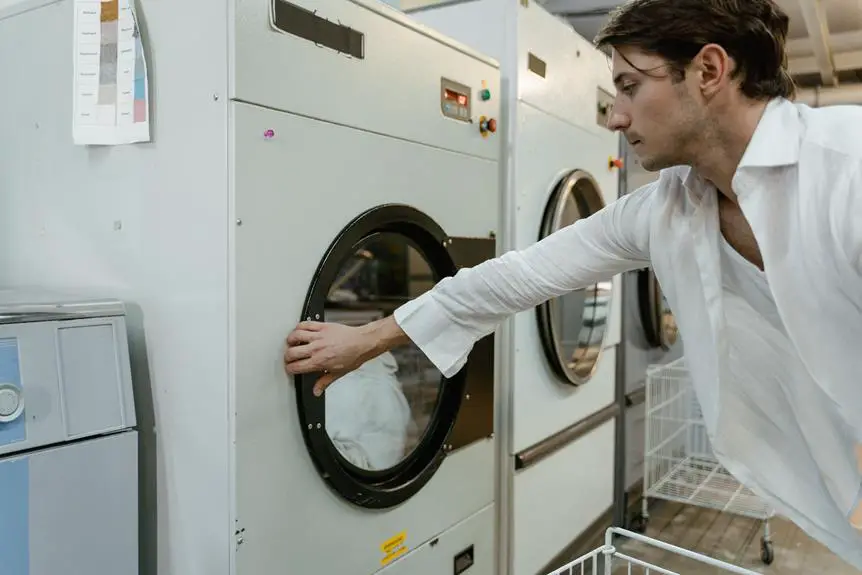To plumb a washing machine drain, follow these steps:
- Choose a location for the drain that is accessible and meets local plumbing codes.
- Gather the necessary tools and materials, including PVC pipes, fittings, and a washer box.
- Prepare the area by installing a standpipe at the required height to ensure proper drainage.
- Connect the drain hose from the washing machine to the standpipe, making sure it is secure.
- Test the setup for leaks and fix any issues found to ensure a reliable installation.
Selecting the Drain Location
When choosing a location for a washing machine drain, it is important to place it near existing plumbing lines and electrical outlets to meet functionality and code requirements. The location should allow for a 2-inch drain pipe made from schedule 40 PVC, suitable for modern washing machines.
The setup should include a 36-inch high standpipe to prevent water overflow and siphoning back into the machine. A correctly installed P trap is required to prevent sewer gases from entering the home and to maintain a water seal. Building codes dictate the distance from the P trap to the horizontal run to avoid creating an illegal S-trap. The distance from the trap weir to the elbow or T-fitting bend must be precise for effective drainage and to prevent clogs.
The drain system must prevent back pressure and ensure ventilation. It should be accessible for maintenance and fit within the wall's stud cavity without affecting the structure. Proper planning ensures a dependable and code-compliant drain system for the washing machine.
Gathering Tools and Materials
After determining the location for the washing machine drain, gathering the correct tools and materials is essential for a smooth installation. It's important to have all components ready as missing an item can delay the project.
Check if the washing machine comes with a discharge hose. If not, obtain a discharge hose with a U-shaped hook to securely attach it to the drain pipe, which is vital for directing water into the drainage system without causing leaks.
Ensure there is a suitable trap to block sewer gases from the home. This trap must connect to the drain pipe to maintain a water seal. The standpipe for the discharge hose should be a minimum of 18 inches above the P-trap weir to ensure proper drainage and prevent siphoning.
Collect any other necessary tools and materials, including a saw to cut the drain pipe to size. Optional items such as a hose clip or U-shaped hose holder can help secure the hose.
Before installation, turn off the water supply to the washing machine and unplug it. With all tools and materials ready, you can proceed with the washing machine drain installation.
Preparing the Plumbing Area
Before starting the installation, ensure the plumbing area is free of obstructions and clean to create a safe and accessible workspace. Clear the area around the washer drain of debris and tools to avoid accidents.
Shut off the main water valve to prevent water flow that could cause flooding or damage. Once the water is off, check the space for the drain pipe installation, ensuring enough room for the pipe, hose, and installation activities.
Inspect the pipe from the wall that will connect to the washer drain, ensuring it is secure and in good condition. If using a 2-inch drainpipe, verify it is the correct type, such as schedule 40 PVC, and that the standpipe will be approximately 36 inches high.
As you prepare the area, look for leaks or wear on existing fixtures and address any issues to prevent future complications. Make sure the area is well-lit to easily identify problems.
Ensure all tools and materials are available and within reach to facilitate a smooth installation process.
Installing the Standpipe
Before installing the standpipe, prepare the pipe cutter and ABS cement. The standpipe is essential for directing water from the washing machine's discharge hose into the plumbing system. It is important to cut the standpipe to the correct length as specified by local codes, typically between 18 and 42 inches above the P-trap weir.
Measure and mark the drain pipe to the required length. Use the pipe cutter for a clean cut, ensuring the washing machine's hose can reach the standpipe without being too tight or loose.
Prime the pipe and fittings, then apply ABS cement to both the pipe and fitting surfaces. Connect the standpipe to the drainpipe coming out of the wall and attach the trap to the standpipe. Make sure the connections are level for good water flow and to prevent leaks.
Ensure the standpipe is in the correct position for the washing machine hose to fit without kinks. The hose should sit a few inches above the trap to avoid siphoning or backflow.
With the standpipe installed, the washing machine's drainage should function properly.
Attaching the Drain Hose
Attach the washing machine's drain hose securely following the standpipe installation. Connect the hose to the machine's outlet and ensure a firm attachment to prevent disconnection. Insert the other end of the hose into the standpipe, making sure it is a few inches deep but not so far as to cause siphoning problems. Use a hose clip or U-shaped holder to keep the drain hose in place and prevent movement during operation.
Consider adding a check valve to the drain hose to prevent backflow into the washing machine. The standpipe height should be between 18 to 30 inches to ensure proper water flow and prevent the trap from being pulled dry.
For optimal performance, the plumbing should have a 2-inch standpipe and trap to handle the volume of water from the washing machine and reduce overflow risk. A secure and proper drain hose installation is vital for the washing machine's efficient and safe operation.
Testing for Water Leaks
After installing a washing machine's drain system, perform a leak test to prevent home damage. First, turn on the water supply and ensure washer hoses are tightly connected to the washer box valves. Look for moisture at the connections and fix any drips immediately.
Then, check the washing machine's temperature control by setting it to a cold wash cycle and confirming cold water fills the tub. If the temperature is incorrect, it may indicate a problem with the hose connections.
Inspect the drainpipe assembly for leaks where the elbow is glued to the stub-out from the wall. There should be no gaps or seepage at the adhesive points. Also, check the standpipe and trap connections to ensure they are secure and the assembly is level to avoid joint stress and potential leaks.





